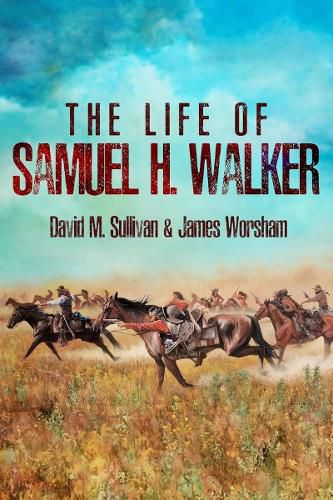Readings Newsletter
Become a Readings Member to make your shopping experience even easier.
Sign in or sign up for free!
You’re not far away from qualifying for FREE standard shipping within Australia
You’ve qualified for FREE standard shipping within Australia
The cart is loading…






Samuel H. Walker was an apprentice carpenter in Washington, DC, when the second Seminole War broke out in 1838, he enlisted in a Washington militia unit and went to Florida. Upon the expiration of the unit's service, Walker remained in service as a scout for the U.S. Army. At the conclusion of hostilities, Walker was employed by then Capt. George G. Meade, USA, in the construction of the railroad from Mobile to Pensacola. Upon the completion of his labors, he removed to Texas where he became a member of the Texas Rangers. He joined the ill-fated Mier Expedition in 1842 and was imprisoned by the Mexican authorities for two years, during which time he developed an intense hatred for his captors. Upon his release, he returned to Texas and re-joined the Texas Rangers. When war broke between the United States and Mexico in 1846, Walker joined a volunteer regiment of Texans known as the Texas Mounted Riflemen. He was subsequently elected lieutenant colonel of the regiment. Prior to the expiration the regiment's service, Walker was tendered a commission as captain, U.S Mounted Rifles, which he accepted on condition that he would not enter U.S. service until his obligation to the State of Texas was completed. His term of service finished, he entered the U.S. Army and journeyed north to recruit his company. During this time, he met Samuel Colt. His discussions with Colt resulted in the Walker Colt pistol. His company filled, Walker returned to Mexico and the scene of battle. He led a furious charge against the remnants of the Mexican dictator Santa Ana's army in which he was mortally wounded by a Mexican sniper. Based upon material from the National Archives, Texas State Library, the Texas Ranger Hall of Fame and other sources, and including copies of his letters-he was a well-educated man and wrote extremely descriptive accounts of his experiences-this is the first in-depth biography of Walker. AUTHORS: David M. Sullivan is the editor or author of several publications, including the four-volume The United States Marine Corps in the Civil War, recipient of the 2003 Brigadier General O. P. Smith award present by the Marine Corps Heritage Foundation. He is the administrator of the Company of Military Historians and editor of its journal. He is also the president of the International Naval Research Organization and editor of its journal. James Worsham served in the US Army Reserve for seven years. He took an MA in History and an MA in Journalise from the University of Alabama. He taught history and journalism for over twenty years, most recently at Bluefield State and Bluefield College, West Virginia. He published a number of articles and lectured widely on historical topics, including Samuel Walker. He died in 2024. 150 photographs and illustrations
$9.00 standard shipping within Australia
FREE standard shipping within Australia for orders over $100.00
Express & International shipping calculated at checkout
Samuel H. Walker was an apprentice carpenter in Washington, DC, when the second Seminole War broke out in 1838, he enlisted in a Washington militia unit and went to Florida. Upon the expiration of the unit's service, Walker remained in service as a scout for the U.S. Army. At the conclusion of hostilities, Walker was employed by then Capt. George G. Meade, USA, in the construction of the railroad from Mobile to Pensacola. Upon the completion of his labors, he removed to Texas where he became a member of the Texas Rangers. He joined the ill-fated Mier Expedition in 1842 and was imprisoned by the Mexican authorities for two years, during which time he developed an intense hatred for his captors. Upon his release, he returned to Texas and re-joined the Texas Rangers. When war broke between the United States and Mexico in 1846, Walker joined a volunteer regiment of Texans known as the Texas Mounted Riflemen. He was subsequently elected lieutenant colonel of the regiment. Prior to the expiration the regiment's service, Walker was tendered a commission as captain, U.S Mounted Rifles, which he accepted on condition that he would not enter U.S. service until his obligation to the State of Texas was completed. His term of service finished, he entered the U.S. Army and journeyed north to recruit his company. During this time, he met Samuel Colt. His discussions with Colt resulted in the Walker Colt pistol. His company filled, Walker returned to Mexico and the scene of battle. He led a furious charge against the remnants of the Mexican dictator Santa Ana's army in which he was mortally wounded by a Mexican sniper. Based upon material from the National Archives, Texas State Library, the Texas Ranger Hall of Fame and other sources, and including copies of his letters-he was a well-educated man and wrote extremely descriptive accounts of his experiences-this is the first in-depth biography of Walker. AUTHORS: David M. Sullivan is the editor or author of several publications, including the four-volume The United States Marine Corps in the Civil War, recipient of the 2003 Brigadier General O. P. Smith award present by the Marine Corps Heritage Foundation. He is the administrator of the Company of Military Historians and editor of its journal. He is also the president of the International Naval Research Organization and editor of its journal. James Worsham served in the US Army Reserve for seven years. He took an MA in History and an MA in Journalise from the University of Alabama. He taught history and journalism for over twenty years, most recently at Bluefield State and Bluefield College, West Virginia. He published a number of articles and lectured widely on historical topics, including Samuel Walker. He died in 2024. 150 photographs and illustrations